| Product name | Anti-β-Tubulin Mouse Monoclonal Antibody (3G6) |
| Immunogen | Synthetic Peptide |
| Host | Mouse |
| Reactivity | Chicken, Dog, Hamster, Human, Insect, Monkey, Mouse, Rabbit, Rat, Sheep, Yeast |
| Applications | IF, IHC-P, WB |
| Applications notes | Optimal working dilutions should be determined experimentally by the investigator. Suggested starting dilutions are as follows: WB (1:10000), IHC-P (1:400), IF (1:400). |
| Clonality | Monoclonal |
| Preparation method | The antibody was affinity-purified from mouse ascites by affinity-chromatography using specific immunogen |
| Alternative | TUBB3; TUBB4; Tubulin beta-3 chain; Tubulin beta-4 chain; Tubulin beta-III |
| Formulation | Liquid solution |
| Concentration | 1 mg/ml |
| Storage buffer | Liquid in PBS, pH 7.4, containing 0.02% Sodium Azide as preservative and 50% Glycerol. |
| Storage instructions | Stable for one year at -20°C from date of shipment. For maximum recovery of product, centrifuge the original vial after thawing and prior to removing the cap. Aliquot to avoid repeated freezing and thawing. |
| Shipping | Gel pack with blue ice. |
| Precautions | The product listed herein is for research use only and is not intended for use in human or clinical diagnosis. Suggested applications of our products are not recommendations to use our products in violation of any patent or as a license. We cannot be responsible for patent infringements or other violations that may occur with the use of this product. |
| Background | Tubulin is one of several members of a small family of globular proteins. The most common members of the tubulin family are α-tubulin and β-tubulin, the proteins that make up microtubules. Each has a molecular weight of approximately 55 kDa. Antibodies against β-Tubulin are useful as loading controls for Western Blotting. However it should be noted that levels of β-Tubulin may not be stable in certain cells, such as adipose tissue. |
| Gene ID | 10381 |
| Alternative | TUBB3; TUBB4; Tubulin beta-3 chain; Tubulin beta-4 chain; Tubulin beta-III |
| Accession | Q13509 |
| Observed Band(KD) | 55 |
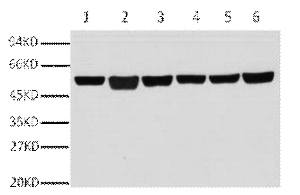
Fig.1. Western blot analysis of A549(1), rat brain (2), mouse brain (3), chicken lung (4) and rabbit testis(5), sheep muscle(6), diluted at 1:10000.
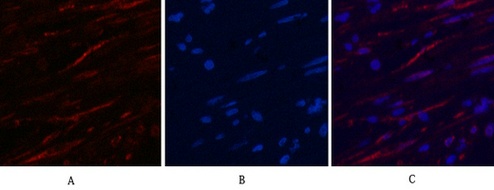
Fig.2. Immunofluorescence analysis of human appendix tissue. 1, β-Tubulin Monoclonal Antibody (3G6) (red) was diluted at 1:400 (4°C, overnight). Picture A: Target. Picture B: DAPI. Picture C: merge of A+B.
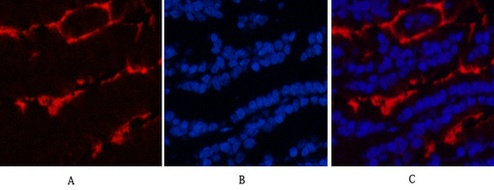
Fig.3. Immunofluorescence analysis of mouse lung tissue. 1, β-Tubulin Monoclonal Antibody (3G6) (red) was diluted at 1:400 (4°C, overnight). Picture A: Target. Picture B: DAPI. Picture C: merge of A+B.
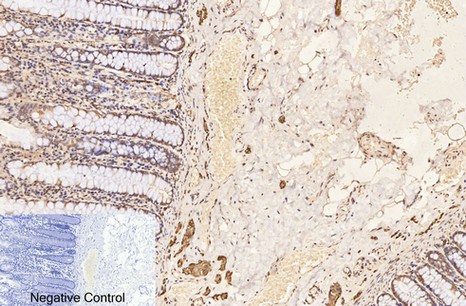
Fig.4. Immunohistochemical analysis of paraffin-embedded human colon tissue. 1, β-Tubulin Monoclonal Antibody (3G6) was diluted at 1:400 (4°C, overnight). Negative control was used by secondary antibody only.
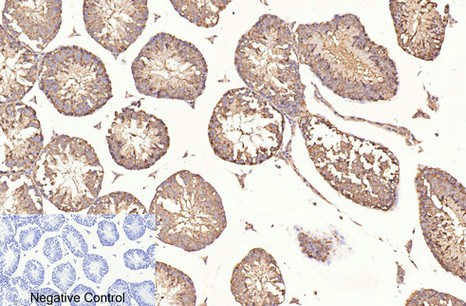
Fig.5. Immunohistochemical analysis of paraffin-embedded mouse testis tissue. 1, β-Tubulin Monoclonal Antibody (3G6) was diluted at 1:400 (4°C, overnight). Negative control was used by secondary antibody only.
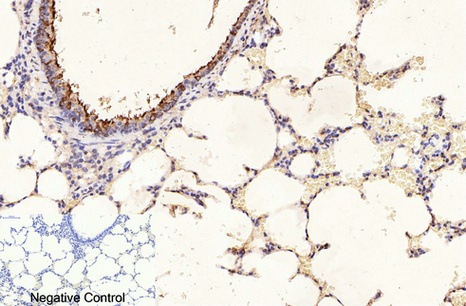
Fig.6. Immunohistochemical analysis of paraffin-embedded rat lung tissue. 1, β-Tubulin Monoclonal Antibody (3G6) was diluted at 1:400 (4°C, overnight). Negative control was used by secondary antibody only.
Author:FC Huo, ZM Zhu, WQ Du, YJ Pan, X Jiang Publication name:Pharmacological Research IF:9.3
Author:Lu, Hui, et al. Publication name:Mbio IF:6.4
Author:S Wang, N Wang, B Yu, M Cao, Y Wang, Y Guo Publication name:Oncogene volume 38, pages6338–6353 (2019). IF:6.29
Author:Liu S, Aweya JJ, Zheng L, Zheng Z, Huang H, Wang F, Yao D, Ou T, Zhang Y, Publication name:Cell Biology and IF:6.284
Author:X Tan, X Wang, X Liao, X Wang, Z Jiang, W Liang Publication name:Iscience IF:5.8
Author:Zhijun Wang, Xiaocui Zhang, Zhenhui Li, et al Publication name:Cells. 2019 Apr 17;8(4). pii: E360. IF:5.77
Author:Erhui Jiang, Zhi Xu, Meng Wang, et al Publication name:FASEB J. 2019 Apr;33(4):5690-5703. IF:5.595
Author:Wang Y, Wu F, Pan H, et al Publication name:Scientific reports, 2016, 6. IF:4.29
Author:Chen, Jiaxi, et al. Publication name:Toxicology and Applied Pharmacology IF:3.8
Author:Sun, Shiquan, et al. Publication name:BMC cancer IF:3.8
Author:Kwon YJ, Seo EB, Kim SK, Noh KH, Lee H, Joung YW, Shin HM, Jang YA, Kim YM, Lee JT, Ye SK Publication name:J Ethnopharmacol IF:3.69
Author:Fen Yuan, Dingkun Wang, Leyi Ma, et al Publication name:Evidence-Based Complementary and Alternative Medicine Volume 2019, Article ID 1232913, 13 pages IF:2.064
Author:Guan‑Nan Wang, Ming Zhong, et al Publication name:Oncology Letters. 2018; 16(2): 1507-1512. IF:1.84
Author:Tian C H, Xie X M, Li Y, et al Publication name:China Biotechnology , 2017, 37(7): 97-106. IF:/
You must be logged in to post a review.
1.The species of antibody reactivity should be the sample species that can be matched normally after Abbkine R&D experts have passed strict scientific verification. If your sample is not within the range of reactivity, in order to improve the efficiency and results of your experiment, it is not suggested to try other species. Otherwise, it may lead to sample mismatch and affect the effect of your experiment.
2.Please aliquot the antibody received as soon as possible and store it at -20℃, avoid repeated freezing and thawing, and use it within one year.
Welcome any form of communications, and better service will be provided here.
Tell: +1-404-854-0155
Email: service@abbkine.com
Support Email: support@abbkine.com
Address: 3052 Stroop Hill Road, Apt 203, Atlanta 30303, Georgia, United States of America




Reviews
There are no reviews yet.